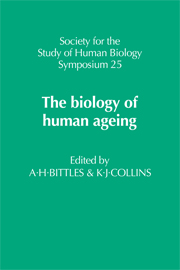Book contents
- Frontmatter
- Contents
- Preface
- Ageing as a consequence of natural selection
- Genetic information in ageing cells
- Insects as models for testing theories of ageing
- Human cell culture systems in the study of ageing
- Estimation of biological maturity in the older child
- Biological age assessment in adulthood
- Skeletal age and palaeodemography
- Cell death and the loss of structural units of organs
- The prospects for mortality decline and consequent changes in age structure of the population
- Where do old people come from? An evaluation of American population projections
- Age structure of Soviet population in the Caucasus: facts and myths
- The health of an ageing population
- Can we tell our age from our biochemistry?
- Dietary manipulation of ageing: an animal model
- Customary physical activity in the elderly
- Effects of ageing on human homeostasis
- Index
Human cell culture systems in the study of ageing
Published online by Cambridge University Press: 06 August 2010
- Frontmatter
- Contents
- Preface
- Ageing as a consequence of natural selection
- Genetic information in ageing cells
- Insects as models for testing theories of ageing
- Human cell culture systems in the study of ageing
- Estimation of biological maturity in the older child
- Biological age assessment in adulthood
- Skeletal age and palaeodemography
- Cell death and the loss of structural units of organs
- The prospects for mortality decline and consequent changes in age structure of the population
- Where do old people come from? An evaluation of American population projections
- Age structure of Soviet population in the Caucasus: facts and myths
- The health of an ageing population
- Can we tell our age from our biochemistry?
- Dietary manipulation of ageing: an animal model
- Customary physical activity in the elderly
- Effects of ageing on human homeostasis
- Index
Summary
INTRODUCTION
The first successful tissue culture was reported 100 years ago when the medullary plate from a chick embryo was successfully maintained in warm saline for 4 to 5 days (Roux, 1885). However, it was not until the introduction of methods based initially on lymph (Harrison, 1907) and later plasma clots (Carrel & Burrows, 1910) that cell culture, as opposed to cell maintenance, became established as a reproducible technique. The link between in vitro culture and lifespan studies was forged at an early stage following the claim that tissue grown in the laboratory was potentially immortal (Carrel, 1912, 1914; Ebeling, 1922). This belief persisted until it was demonstrated that human fibroblast cultures had a finite, reproducible lifespan (Hayflick & Moorhead, 1961; Hayflick, 1965), a finding which primarily was responsible for the rapid adoption of cell culture methods in the study of ageing. Evidence that the lifespan of diploid fibroblasts in vitro was governed by the number of their cell divisions rather than absolute time in culture (Dell'Orco et al, 1973; Goldstein & Singal, 1974; Harley & Goldstein, 1978) served to further emphasize the potential of cell cultures in this field of research.
A number of authors have disputed the validity of fibroblast models in the study of ageing on theoretical and practical grounds. For example, it has been proposed that the loss of division potential exhibited by ageing fibroblasts represents differentiation into a non-cycling stage rather than senescence per se (Bell et al, 1978).
- Type
- Chapter
- Information
- The Biology of Human Ageing , pp. 49 - 66Publisher: Cambridge University PressPrint publication year: 1986
- 2
- Cited by



